Burmese Python Care
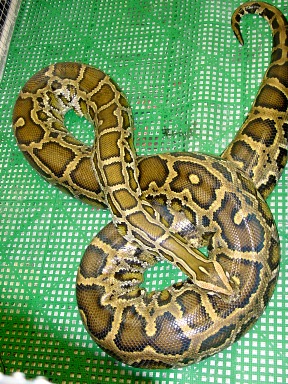 |
| This was our big baby. She was 16 feet when she passed away. |
Common Name: Burmese Python
Scientific Name: Python Molurus Bivittatus
Homeland: Burma, China, Indonesia, Thailand, and SE Asia
Size: Huge! They can get 15-20 feet long and 150 pounds. And boy, do they grow fast.
Lifespan: 25 years if not longer when properly cared for.
Housing:
I hope you have a lot of room and lots of money cause you got a biggie!
Cage:
When they reach about 4 feet I believe that it is best to get a cage that will last them their entire life. That's 25 years my friends, be prepared. My first Burm that I hatched from an egg is 12 feet now and to heavy to lift. Her cage is 6 feet wide and 8 feet deep and 5 feet high. That's an apartment-sized bathroom. It was custom built at a cost of over $2,000.00. This cage has two levels in it along with Infrared heating panels to keep its temperature perfect 24 hours a day year round. Burms DO need a lot of room to move around and climb although not too often for the really big guys but often enough that you will be depriving them if you don't. This allows for good muscle tone to develop. This is important, a costly cage is part of python ownership. If you don't have the money don't get the pet.
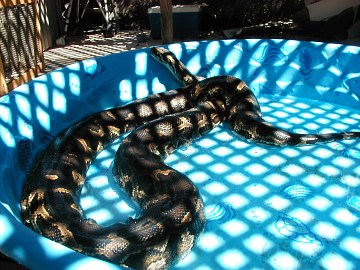 |
| Augustavia getting some fresh air and a bath |
iIt is not recommended to let them roam you house or keep them in a spare room. Rooms ment for human occupancy are not built to withstand the humidity and constat disenfection required.
Substrate:
I have found that Dr-dek (the rubber mats used behind most Bars and in kitchens at restaurants or in shower stalls) work great. They are raised off the ground so the pee runs under and your pet is not always walking or slithering through it and it hoses off easily for disinfecting. Wood chips can hold mites. Bark also. Newspaper leaves ink especially visible on my beautiful albinos. The rubber mats have lasted me over 10 years now.
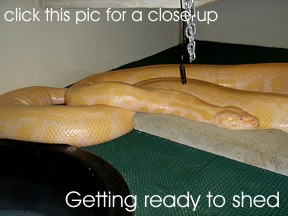 Behavior:
Behavior:
They call them the gentile giant. "They" never saw them at feeding time! They are very gentile but due to the incredible size they can also be dangerous. Some are just sweet as can be and a few somehow end up being nasty as their closely related in size buddies the Reticulated Python. You must handle these guys often to keep them gentile or one day you will have 20 feet of unhappy animal to pry off your leg. It will be your fault if the only time you handle them is feeding time. Most act kind of floppy in handling and will even fall out of your hands if you don't hold them up. Constant interaction is a must.
Temperature:
Daytime temps range on one side of their cage starting at 80 degrees to 92 on the far
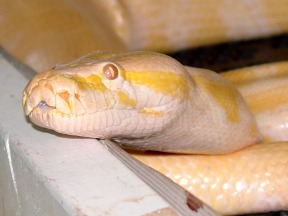 |
| This is Chablis. One of the few snakes we had as a baby. Even with optimal care at 9yrs old she had an acid blot adhere to her rectal wall. She became infected after surgery and sadly did not make it. We miss her. |
end. Now I keep it that way year round. This gets expensive on the ol' electric bill.
Humidity:
I have an inexpensive vaporizer blowing in steam 8 hours a night, every night. The humidity is good for boids but tuff to clean. It makes a great place for mold and bacteria to grow. Daily cleaning is a must. If you do not like that idea don't get the pet. Another way not so troublesome but better than nothing is to get a plastic shoe or sweater box at K-mart or such and fill the bottom with vermiculite. (Find it in the gardening section.) Add enough water so that when you squeeze a handful it clumps up and breaks apart if you poke it with one finger. You'll get the idea when you try it. Then cut a hole in the lid big enough for your snake to climb through and he will hopefully go in there for his humidity. Not to efficient for big snakes but sufficient for the little guys like ball pythons and especially rainbow boas. It also acts as a great shelter for the smaller snakes too. One last thing 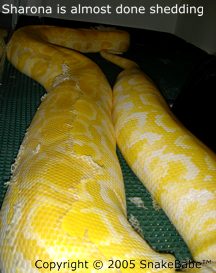 here, pick up a hygrometer to keep track of the humidity. I have the digital thermometer/hygrometer combos but you can pick up inexpensive ones at Walmart or Radio Shack.
here, pick up a hygrometer to keep track of the humidity. I have the digital thermometer/hygrometer combos but you can pick up inexpensive ones at Walmart or Radio Shack.
Shedding:
My kids do every 4-6 weeks. Do not handle them during this time. Make sure water is available for soaking.
Feeding: As babies it is easy but they grow fast. They will over eat if you let them, which can lead to vomiting. All my snakes are offered food every 10-14 days, except hatchlings of course. Feed rodents or rats of appropriate size. Look at the roundest part of the snakes body and give them food that will fit in there without a lump. I don't handle my larger snakes for at least
4 days after they eat. Never feed live food. (see my general care on frozen/thawed) Many of my kids have got to the point where I just leave a food item on the floor and they casually move up to it and start to eat. Keep a feeding chart. This will be helpful to your Veterinarian if problems arise. This is difficult with a large snake so I use an aluminum water trough.
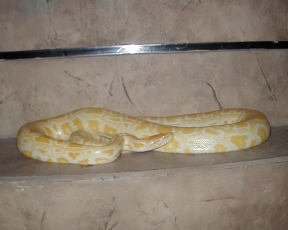 |
| This is little Sharona. She came in to us with mites and had pseudomonis. The mites were easy to get rid of but she received antibiotics and fought hard. Like many sick snakes we get she did not recover. |
Comments:
Size, size size. When you have a full understanding of these three elements of Burmese python care you will know if you should get one. I hope you reconsider.